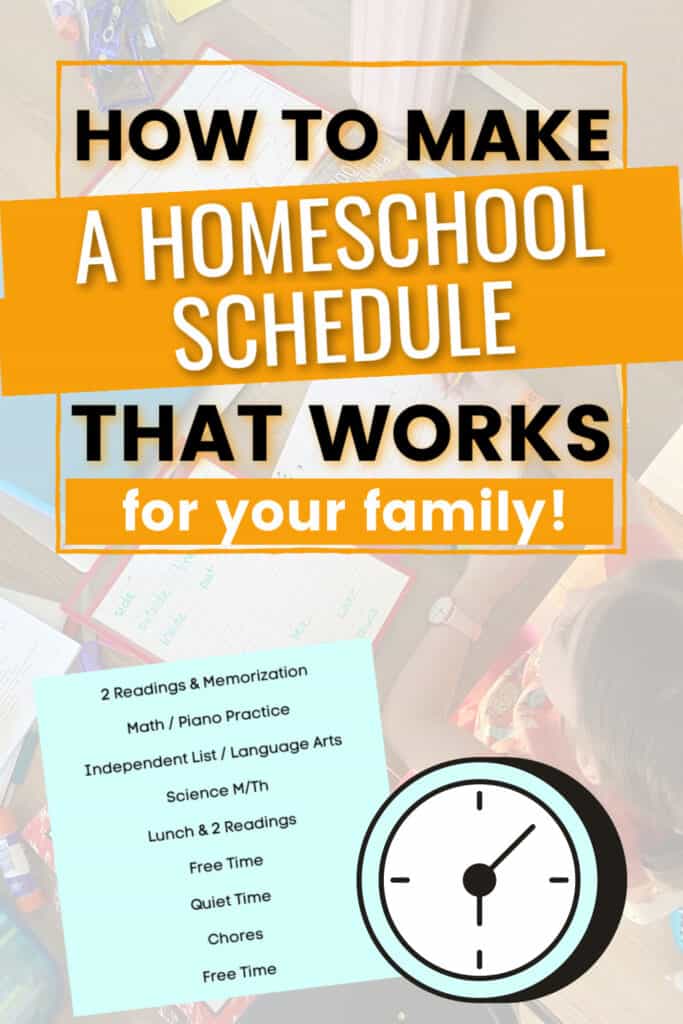Today, I’m going to explain how to think about and create a homeschool schedule that will work for your family.
The freedom and flexibility in homeschooling is a wonderful thing, but the flip side of that same coin is it can feel like a daunting task to plan out exactly what your homeschool might look like.
We’ve homeschooled through having babies and toddlers and through other big life changes. I’ve also talked to several homeschool families with drastically different schedules from ours.
At the end of the day, you get to create a schedule that works for you. That’s one of THE BEST parts of homeschooling.
So, let’s dive right into the key elements to consider when figuring out your homeschool day.
Work Backwards From Your Goals
The majority of current homeschool parents were not homeschooled growing up (myself included)! It can be difficult for us to think outside the traditional public school/ private school box and imagine what school at home might look like.
Keep in mind, the possibilities for your school time are endless! Every homeschooling family I’ve met has a slightly different rhythm to their day. The important thing is educating your children well. And the good news is, there are lots of ways to do that.
Your homeschool doesn’t have to look like anyone else’s. The first thing you’ll want to do at the beginning of each new year is set goals for the homeschool year. Think big picture!
To figure those out, grab a blank piece of paper for each child that you’ll be teaching and jot down what the child will be working on that school year. Some possibilities might be:
- Math
- Learning to read
- Reading history & literature as a family
- Science experiments once a week
- Memorize 5 poems
- Music lessons
- Art skills
- Other hands-on skills
- Habits – putting belongings away; helping with mealtimes
- Service and Chores
State Requirements
Homeschool law varies by state, and knowing your state’s legal homeschooling requirements ahead of time will save you potential bureaucratic headaches later.
Some states require a certain number of days or hours of instruction. Within those hours or days, some states specify what must be taught and others don’t. Some states require you to keep logs & portfolios, others don’t. Our state simply requires you to fill out a form notifying the department of education of your intent to homeschool.
It’s always a good idea to check HSLDA (Home School Legal Defense Association) before you start homeschool planning. Their website provides detailed requirements for each state’s homeschool laws. Knowing whether or not you’ll have to turn in records will factor into how you plan and track your homeschool schedule.
However… homeschooling is VERY flexible. You can often make something non-traditional ‘count’ for a variety of hours. Reading a biography, for example, can count for literature, history, or geography (if you spend a little time studying the relevant maps). So, don’t worry too much about trying to make your homeschool fit a detailed list of requirements. I heard Andrew Pudewa say once, “Do what you need to do and then make it count for what it needs to count for.” Ha! Now that sounds like the advice of a homeschooler.
Big Picture Yearly Schedule
Once you have some goals & state requirements written down, you can plan out the entire school year. Remember, when homeschooling, you don’t have to stick to the traditional schedule public school calendar unless you want to!
Some example yearly schedules might be:
- 4 weeks on, 1 week off year round
- 6-8 weeks on, 1 off with longer summer/ winter breaks
- 4 day school weeks
- 5 day school weeks, with 2 days being lighter
- Labor Day to Memorial Day
- Relaxed, year round homeschooling breaking as needed
- 16.4 days per month, flex
Did you notice that last one!? A common elementary school year requirement is 180 days of instruction. 180 divided by 11 months a year is 16.4 days per month. Assuming you lose about a month to celebrating holidays & other life events, you can divide the 180 days by 11 months to get 16.4 school days per month. Just get that number of days in whenever you want and you’re good.
Plus, most states don’t require you to do, for example, “math and language arts worksheets for 180 days.” Cooking & cleaning together – math & science & home economics… count it as a homeschool day. Did you explore a forest preserve on vacation? Science ✅
Learning happens all around you. It can all ‘count,’ if you think outside the box. Which is one of the whole points of homeschooling.
By the way, 180 days in an arbitrary number. Don’t worry about that number unless you’re legally required to track & report it.
Disclaimer: This isn’t legal advice! If you have an actual question about tracking requirements in your state, join HSLDA and ask them! We are members even though our state is very low regulation.
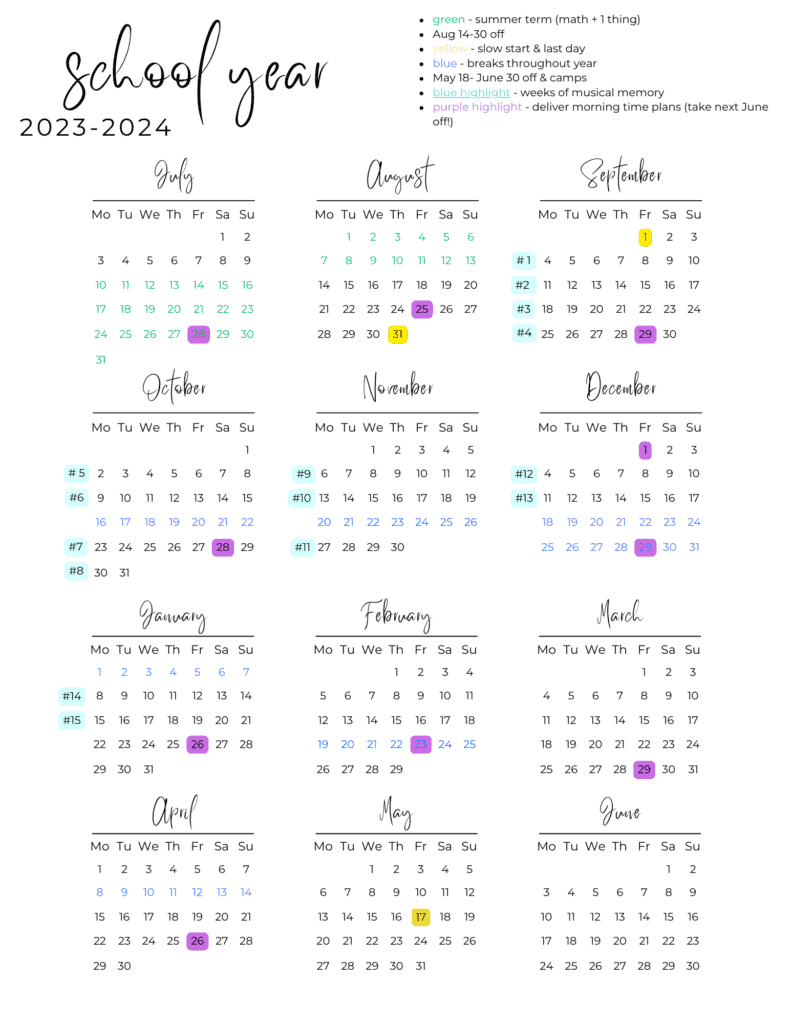
Get more specific help planning your own homeschool year in my Plan Your Homeschool Year Workshop.
Margin
Make sure your plans have room for margin. This might sound silly, but it’s an important tip I’ve heard repeatedly from seasoned homeschoolers. A good homeschooling schedule always has margin in the year, months, weeks & days.
Don’t over plan every single day down to the wire. Things will come up and you’ll end up feeling stressed and behind.
It’s tempting to fill up all the hours and days… in the spirit of efficiency or working hard or learning as much as possible. But, remember, learning happens in all kinds of things in life. So, leave some room for life.
Monthly & Weekly Schedule
Before the school year starts, I glance at each month and make note of the things we already have scheduled. You can do this on your phone, favorite paper planner, or just print out some blank calendar pages. Your list of events to write down might include:
- Special occasions
- Visits from out of town relatives
- Field Trips
- Co-op events
I use my phone calendar app for keeping track of all events, activities, etc.. Then, I transfer it into my bullet journal at the beginning of each week for a more detailed look at the actual upcoming week. (The Bullet Journal Method | my current notebook | my preferred pens.)
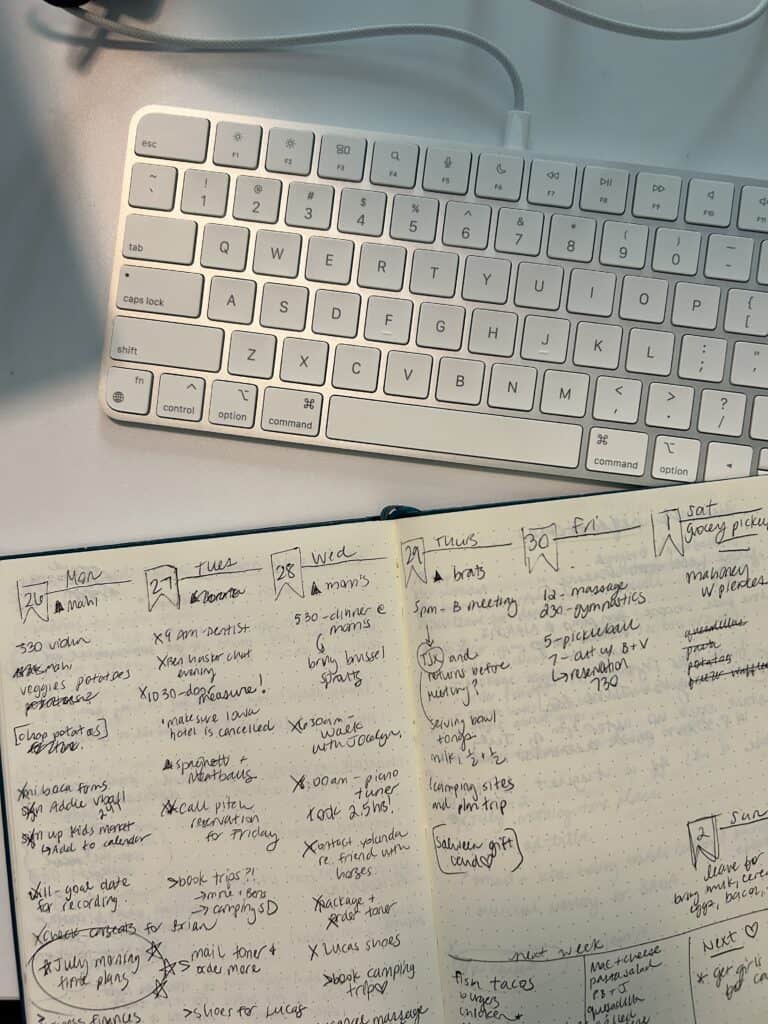
As I see the whole month or week laid out, I can usually adjust school plans accordingly so that we are making progress and also have margin.
Seasons Based Schedules
After a few years of trial, I realized we really like to season-school. Meaning, our school hours vary with the seasons. We spend way more time doing extra bookwork and optional indoor activities in the middle of winter…
- hands-on science kits
- typing lessons
- drawing lessons
- crafts
- educational videos & documentaries
- making homemade movies or other computer-based projects
When spring rolls around, our kids want to be OUTSIDE all the time! We usually take a break to soak up the first week of warm weather and then make a plan to finish the school work for that academic year before summer.
During the amazing spring months, you can complete fewer bookwork-style school hours, but still learn a ton. Gardening, nature exploration, and unstructured outdoor play are important for kids! You can take school work outside too. (Here are 2 articles with ideas about math & other routines in the summer!!)
When the weather is nice, we set short-term goals each day for how much school work someone needs to complete before a play break. Often, I’ll say something like, “You need to check 3 school activities off your independent list before you go outside for a recess break.”
Remember, lots of learning is going on when kids get unstructured outside play time! (Read this book if you like science & need to be convinced. Or this much shorter article by the same researcher/ author.)

Weekly Schedule
Think about yours and your children’s personalities and lifestyles to figure out what types weekly rhythms will work for you.
Your weekly rhythms may be completely up to you, or they may be dependent on other life circumstances.
I use a blank document like this to create our weekly rhythms.
Download for Free Here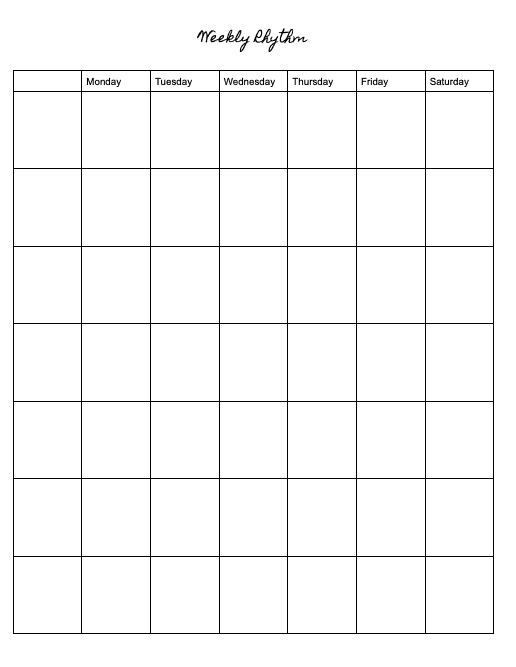
Many factors influence what your homeschool week might look like! Some questions to think through as you create a new schedule are:
- Do you want to do a little bit each day for 5-6 days, or work in longer chunks for 3-4 days and leave other days completely free for other life stuff & extracurricular activities?
- Can some children work independently in some areas?
- Are you juggling a work schedule that dictates your hours?
- Are you more energetic in the mornings or evenings?
- Are there babies and/ or toddlers in your home?
- Are you in the midst of a family crisis that is taking up your energy and time?
There is no perfect homeschool schedule. Different families have different needs, and at the end of the day, you get to determine your own homeschool schedule based on your family’s priorities.
Most families I know tend towards a rhythm or homeschool routine rather than a schedule of specific times. Meaning, rather than demand math be completed between 9-9:40, you create a daily rhythm that is: breakfast – clean up – start math around 9.
That way, if the toddler has a potty accident at 9:02, your entire day isn’t “ruined and behind” because you started math at 9:15.
Here are some sample schedules for scheduling your weekly routines in various situations.
Working from Home While Homeschooling
If you are working from home during the day, give your kids independent lists each day. Check in as you’re able and plan to do the 1-on-1 lessons in the evening, or whenever you can be done with work.
Make sure they get free time & play time during the day if you’re going to do evening school, so that they’re not burnt out and unable to focus.
Work schedules can make homeschooling challenging, but lots of single parent or 2-parent working families choose to homeschool! It can totally be done… Check out Practical by Default. The author there, Jen Mackinnon, has a ton of great resources specifically for moms who are trying to work a demanding job while homeschooling.
Sample Work From Home Homeschooling Schedule
6:00 am – Mom starts work early
7:00 am – Kids make their own breakfast & get chores done
8:00 am – Check in with Mom for today’s work list
9:00 am – Mom works while kids work through independent work lists. (Tip: Assign time slots for computer if multiple kids need access throughout the day.) Depending on the age of child & amount of work, you might say 30 minutes of work to earn 10 minute recess break. Or, finish 3 independent work things, then take a 10 minute recess. Or whatever makes sense for your kids!
11:00 am – Check in with Mom & lunch break all together. Chat & discuss where kids might need help with schoolwork
12:00 pm – Play quietly/ color/ hands-on crafts while listening to audiobooks. Build up listening attention until kids can listen/ play for 1-2 hours. (We love Scribd – it’s like Audible meets the library audiobooks! $10/ month everything on there is free! Tons of great options.)
1:00 pm – Free time!
3:00 pm – Mom wraps up work day, takes a break, and then finishes lessons as needed.
4:30 pm – Family tidy & media time
5:00 pm – 20 minute dinner prep (kids help as able!?)
6:00 pm – family dinner & liturgical/ “morning time” basket style family learning… poetry, read-alouds, memory work, interesting topics, current events, whatever “extra” you feel like you can’t fit in to the day.
Homeschooling with Babies or Toddlers
Our schedule changed often while we had babies and toddlers in the mix.
If you are trying to teach a challenging subject to big kids with younger children around, find a time of day where you can consistently be available to focus on work with the older students. Perhaps nap time, 9:00 pm, or when there are other adults around to help out.
Also, train older kids to work relatively independently on a few things when the littles need you. You might enlist hired help a couple times a week. You can also have older children supervise babies & toddlers nearby while you work with another child.
6:00am – mom/ babies up
7:00 am – other kids allowed to wake up, consider bible storybook reading on the couch
7:30 am – breakfast & breakfast cleanup
8:00 am – picture based chore system (mom helps kids learn to do simple, achievable morning chores.)
8:30 am – morning time style lessons if baby is happy/ contained. OR kids start independent work
9:00 am – baby naps, toddlers make a mess, mom teaches big kids as efficiently as possible 🙂
10:00 am – play/ outings/ family life
11:00 am – kids finish independent work (if old enough) with mom nearby
11:30 am – lunch/ outside
afternoon nap – everyone rest for half the baby’s nap, then mom finish lessons with big kids.
2/3:00 pm – read alouds (audiobooks count!! We love Scribd – it’s like Audible meets the library audiobooks! $10/ month everything on there is free! Tons of great options.)
4:00 pm – tidy house, then either play outside or watch a show. Prep dinner
evening – family dinner & clean up
Idea – You could move read-alouds to bedtime if the baby goes to bed earlier than your other kids.
Try Various Schedules
If you have a lot of freedom and flexibility to determine your schedule, write out your ideal weekly rhythms and give it a try for a month! Jumping in and trying what you think is your ideal is a good starting point.
You can evaluate how things are going and make changes as needed.
Daily Schedule
Again, there will be as many different ways to plan your homeschool day as there are homeschooling families! These tips provide a general guideline for working on your own homeschool schedule.
Start & End
To figure out your daily homeschool schedule, think about start times and end times first. When do you want to start and end your school day?
I’m a morning person, so I prefer to the bulk of teacher-intensive work before lunch. After lunch, there is lots of independent reading during quiet time, art, free time, playing outside, piano practice, playing with friends, etc.
If you have a baby, you might do nap school, where you complete the most intensive work during that morning nap and afternoon nap with a break in between.
A friend of mine works nights, so her kids wake, eat, and play independently in the morning while she sleeps in, then they get schoolwork done between 11 am and 3 pm.
Combine Whenever Possible – Stack Learning!
Remember, learning can happen anywhere, so keep working to think outside the box of kids-in-desks-with-worksheets. I love “stacking” an educational item onto something we already do.
We already eat breakfast together every morning, so I add on a few of our school readings to be done during and after breakfast.
If your family has a bedtime reading routine, stack a few read-alouds from your curriculum onto that time. If there is written work for that book, it can be completed the next day.
If your family drives 20 minutes to and from an evening activity, bring your musical musical math memorization or an audiobook in the car.
Margin
Add 15 minutes to everything in your plan so that when something comes up, you aren’t stressed the rest of the day.
If you are gone for 2 hours in the afternoon, pretend like it’s 2.5. If you expect math to take 45 minutes, plan for it to take an hour.
Homeschooling happens in your real life… meaning things will come up! Even seasoned homeschoolers experience unplanned interruptions or chaotic days. Building in margin to your daily homeschool schedule will definitely save you some stress in those moments.
Post the Schedule & Expectations
I’d recommend posting your schedule in a format your kids can understand.
I’m pretty free spirited and don’t personally like to be boxed in to a “Spelling at 10:15” type schedule. I resisted posting a schedule for a long time because every time I tried to declare a new homeschooling routine, the baby or toddler would inevitably have a pressing need right after breakfast when we were supposed to start the elusive morning time.
BUT, eventually, I created a routine that was conducive to our actual life, and not someone’s Instagram version of homeschool. I’m convinced no real homeschooling happens on Instagram, haha 🙂
Then, I posted it and explained it to our kids – both the kids and I were happier & more focused!
These days, I just write out our plan for the day on a whiteboard in the kitchen. The white board is the easiest because while we do have lots of standard routines (a math lesson rotation system, for example), our plans change a lot week to week… one week, the kids might spend an afternoon with Grandma. Next week, we might do a field trip with friends. We all love having the day’s plans written out in the morning.
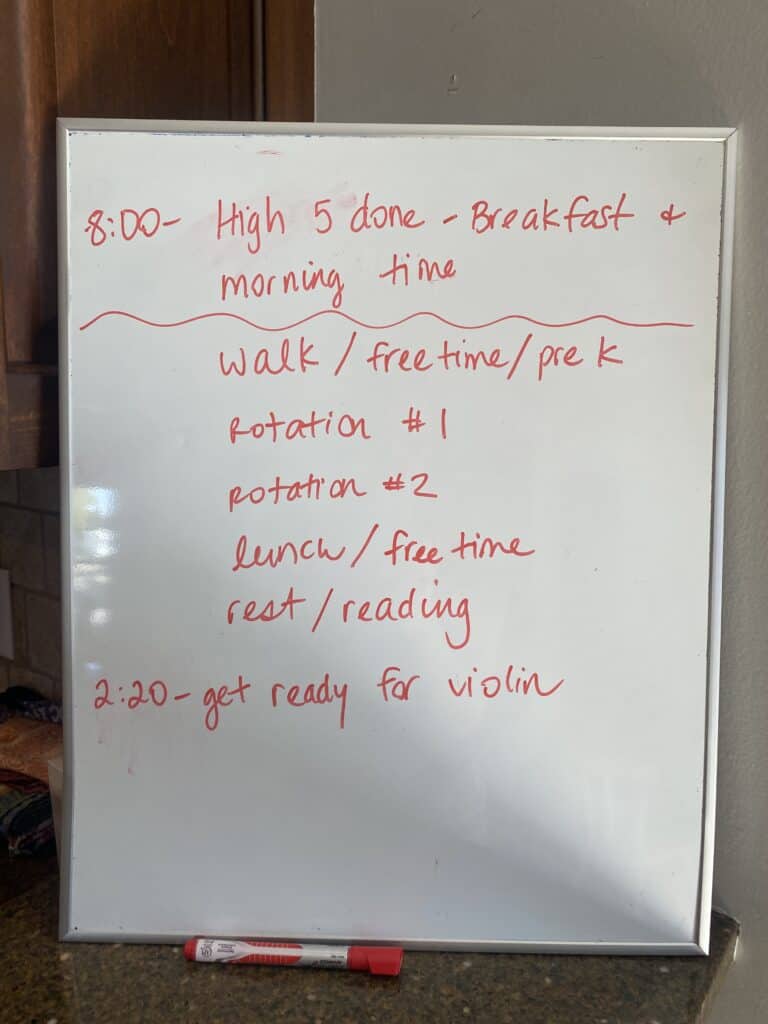
There was less arguing or figuring out what to do when because the routine was posted and we all just followed it. (My free spirited self included!)
Yes, interruptions will arise, but with a good routine, you can just pick up where you left off.
If your kids are old enough to read, the daily routine might be a simple list like my whiteboard list above.
Or maybe the list will vary slightly depending on the day of the week. You could create a schedule on Canva for free and change the background color for each day of the week. Laminate them, add adhesive magnets to the back and hang the appropriate one on your fridge each day. Here is my inexpensive laminator that comes with the pouches & adhesive magnetic stickies.
Or if you’re more Type – A, make a color coded excel sheet & print it off! You can have time blocks in your schedule, but cut yourself some slack if the day gets off-schedule now and again. If you get off schedule, cut something out to get back on track or go to “routine mode,” where you just keep doing the next thing on the schedule even if it’s not on time.
There are free schedule templates in Canva too. (Aren’t they pretty!?)

If your kids aren’t reading, you can print simple clip art pictures and post them in order top to bottom OR left to right on the fridge as pictured below.

General Scheduling Tips
1. Use Pencil
You don’t actually have to use pencil, but I’d recommend holding your plans loosely. Be open to change if needed.
For what it’s worth, I use a bullet journal because it’s 100% customizable and I write it all in pencil.
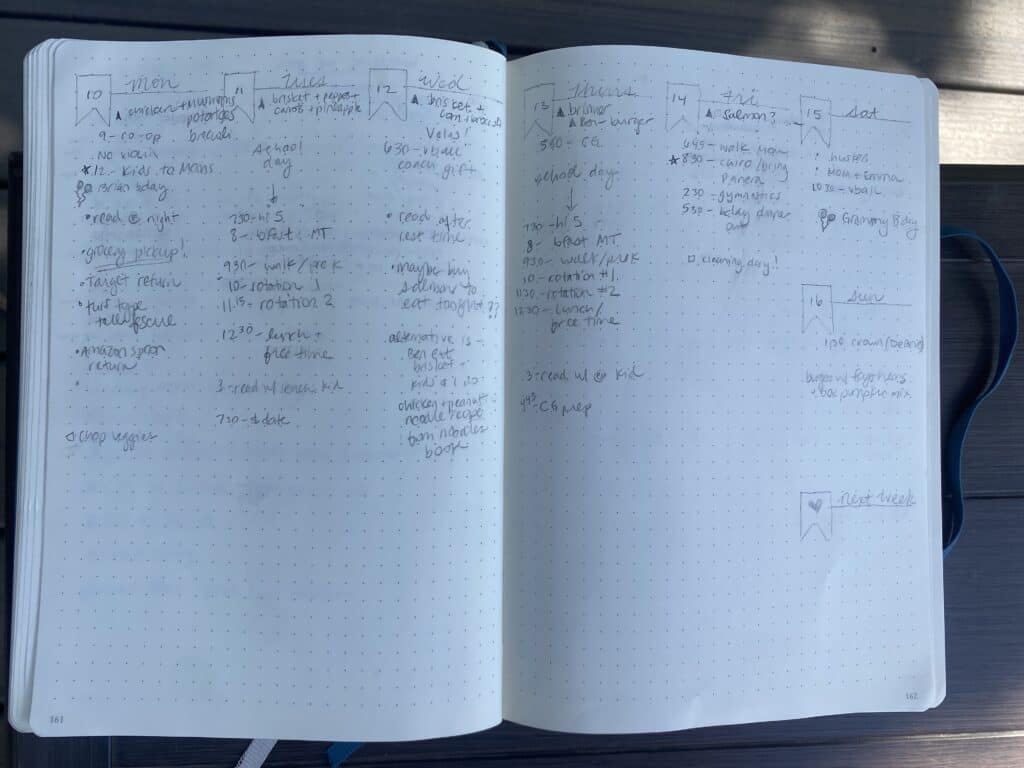
2. Be Realistic
Be honest and realistic about your situation when creating a schedule. If you’re having a baby or moving or a grandparent is coming to visit from overseas, do not plan for intense schooling that month.
If you have a really busy 17 month old, you may have to pick and choose the most important things to cover at a time of day that works well for your toddler. In 3-6 months, things will be different.
3. Combine Different Subjects and Ages Where Possible
If you have multiple ages of children, combine subjects whenever you can. When the kids were all under 6 or 7, I did most of our reading before bedtime (after the baby or 1 year old was in bed).
Now, we do all of our fun read alouds plus science, history, & memorization together as family during morning time right after breakfast. I keep all our resources in a cart near the table and we just rotate through the books, poems, etc.
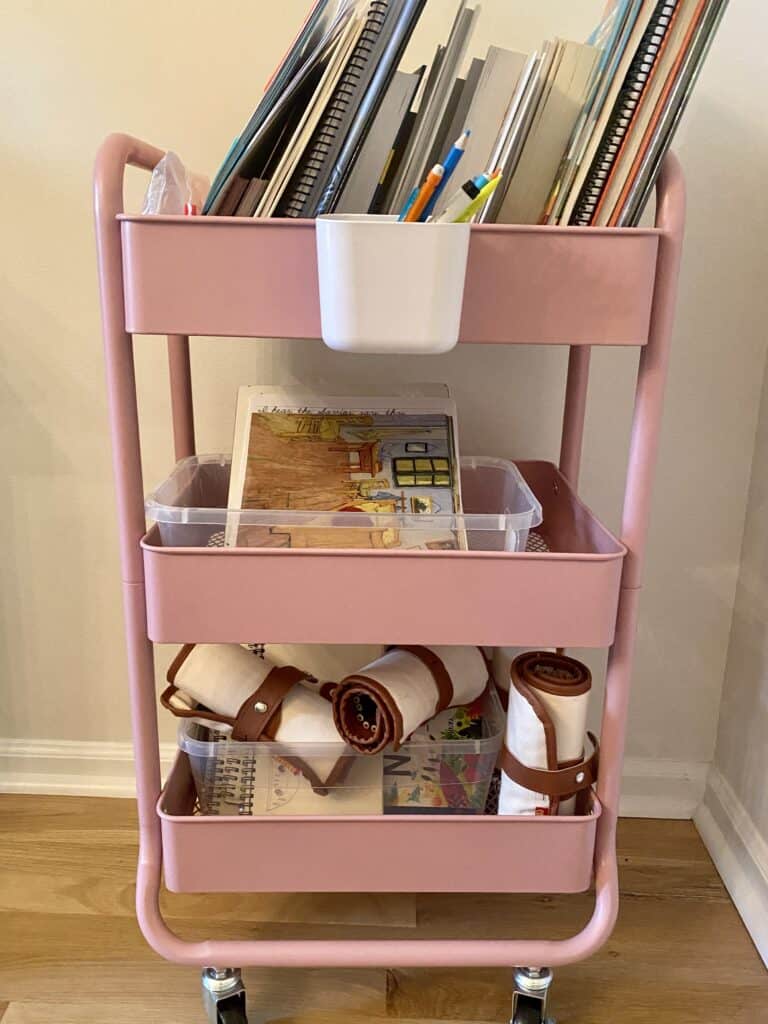
If you have a very wide age gap in your homeschool, you can do some of the basics together, and assign more reading and writing for the older students on the same topics.
4. Give Yourself Teacher Prep Time
Bock out some focused time before the beginning of the school year, during breaks, and during each week for “teacher prep time.”
The primary educator(s) in the home need time and mental space to think about lots of things:
- Where your kids are at
- What you’ll be focusing on this year
- Ordering & printing materials
- Organizing your space & supplies (here are the ones we use all the time!!)
- Reading & learning
I brain dump all of these types of thoughts & lists in my bullet journal.
My Plan Your Homeschool Year Workshop walks through how to take your big picture thoughts about your kids and narrow down specific curriculums, lesson plans and schedules to make it all fit together. You can watch a couple videos for free here.
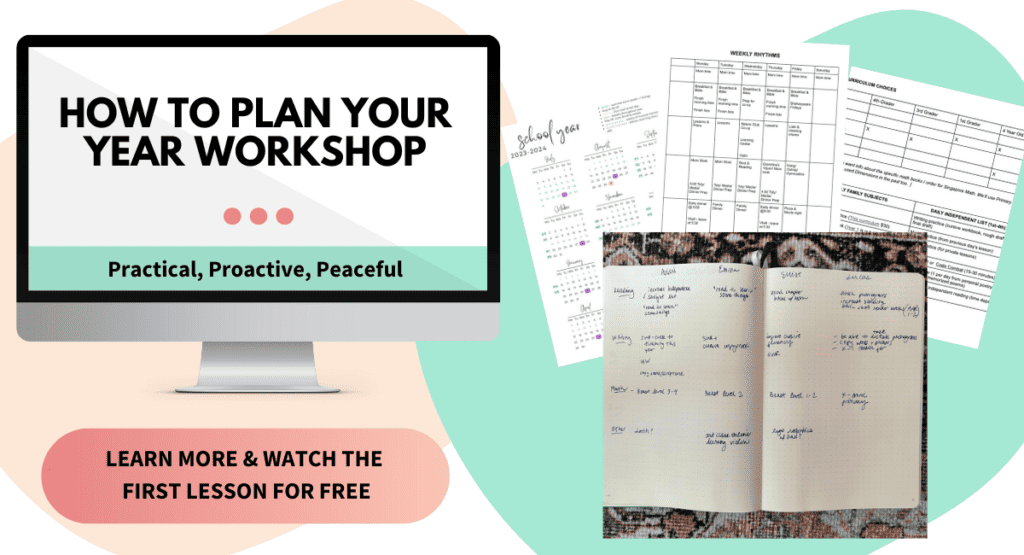
5. Plan Meals
Trust me on this one. The last thing you want to do after a day of homeschooling is figure out what’s for dinner. I meal plan ahead of time (by the month!) & try to batch dinner prep as much as I can by chopping tons of veggies & cooking up some meat at the beginning of the day or week. (I actually love making dinner in the morning. Whenever possible, I get something done for dinner prep as I’m cleaning up from breakfast.)
Even if you don’t love meal planning or prepping, your future self will thank you for doing some of these things in advance.
Get Organized
Once you have your general goals and schedules outlined, you can work to get your school supplies & space organized. Here are our favorite office, art, math & school supplies for homeschooling.
Good luck & feel free to reach out via email or on Instagram if you have any individual questions!
RELATED: How many hours a day should you spend homeschooling?
